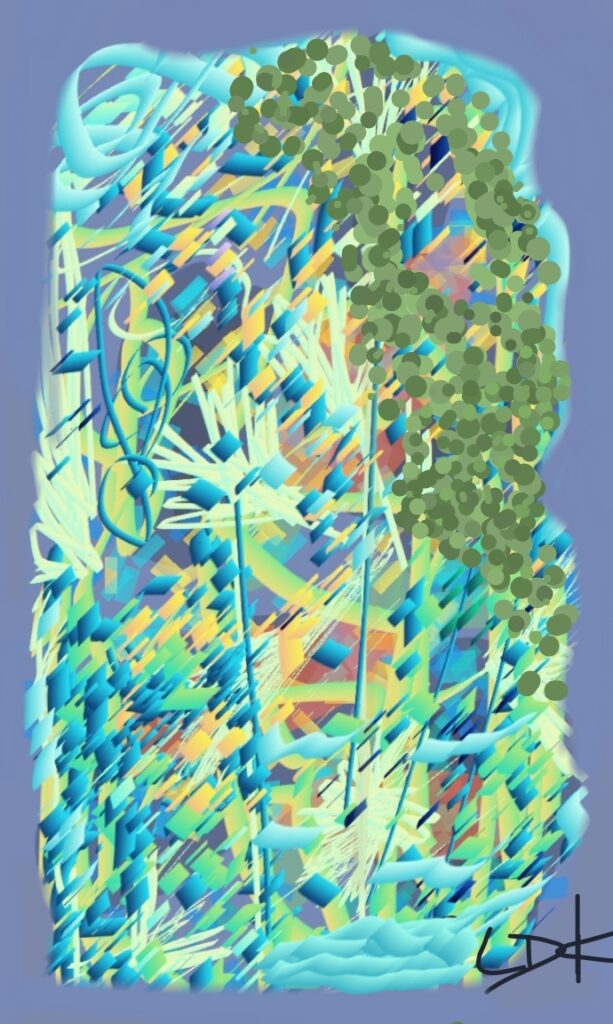The beginning of 2024 saw some still having to contend with the cleaning up of debris from storms that occurred across several parts of the world in December of 2023; where heavy rainfall quickly turned into flash floods, across places such as Southern California, the Philippines, Argentina, and also The Democratic Republic of Congo.
In many instances; heavy rains quickly turned into soil erosion and mudslides across many areas, damaging infrastructure and causing power outages.
On September the 29th of 2023, N.Y.C experienced it’s wettest day on in over a hundred years; with millions of people put under Flood Watch as a State of Emergency was declared. Flash Flooding occurred at several Subway Stations across New York, with flooding also occurring at La Guardia Airport.

Artwork: Copyright of L.D.K
(With an estimated seventy-two percent of N.Y.C being impervious in the sense of having solid concrete roads; flooding looks like a more common occurrence in regard to Climate Change).
In October, going right the way through to September of last year in 2023; several more areas in the U.S.A were impacted by windy coastal storms along with power outages that occurred across the Carolina’s, along with other places such as Maine, N.Y, New Jersey, New Hampshire, Massachusetts and Connecticut.
Providence as well as other areas in Rhode Island also experienced stormy coastal weather along with power outages.
In late December of 2023, several areas of the U.K including Manchester experienced heavy rainfall from the 80 m.p.h tornado impact of Storm Gerrit.
Parts of Scotland were also affected by the severe stormy weather with power outages and damage to some buildings.
Indeed, storms did not look as though they had any intention of slowing down any time soon over the course of last year in December of 2023; as severe stormy weather made it’s way across Arizona, Southern California and L.A along with San Diego, all of which were impacted by severe flooding from weather storms.
The area of Ventura in California experienced a whole month of rainfall occurring in just one hour.
As some areas of the world have been impacted by stormy weather, (including severe snow storms across areas such as Canada and Tokyo); other parts of the world, such as regions of Spain and the Amazon Basin have been continuing to experience the full El Nino effect amidst unusually warmer and drier conditions which have given rise to the spread of wildfires.
The warming of the Pacific and the North Atlantic Ocean have been a major contributing factor; resulting in a lack of cloud formation over the Amazon, and disrupting what would otherwise be normal rain patterns across Amazonia.
It has also been reported that the prolonged drought conditions are not set to change until some time in May of 2024. Colombia has suffered over 42,000 acres of wildfire damage, whilst over ninety concurrent wildfires have occurred across many parts of Chile.
Meanwhile regions across the Amazon Basin that are currently experiencing an extended period of drought are still struggling with the severity of this drought, in terms of food and drinking water, as fresh water levels have dropped rapidly with rising temperatures heat the evaporating river levels up to 39 degrees Celsius, leaving marine life such as fish and Amazonian Dolphins to cook in the heat and perish.
As previously mentioned, the average water level of interconnecting rivers (i.e tributaries), has fallen by at least 40 feet.*
Amidst the present occurrence of prolonged drought conditions across the Amazon; which is experiencing some of its lowest fresh water levels in over a hundred years; there have been several reported cases/incidents of individuals who have violated Emergency Drought Crisis Guideline Protocols, -(in regard to fresh ground water usage rights for everyone i.e all of humanity,-and which includes Indigenous Communities across the entire Amazon Basin)-by the refusal of some individuals, to share, what is in fact diverted water that is traced back to drinking water access points-belonging to natural, fresh ground water locations which are actually sourced both from and within close proximity to what is in many cases encroached Indigenous land; and these types of incidents need to be investigated, along with the right course of action to be taken against those who are in violation of such Humanitarian Emergency Water Usage Protocol Guidelines.
It has also been reported that such fresh water diversion has also impacted one or two Urgent Treatment Medical Centres which are already extremely few and far between across the entire Amazon.
In terms of shifting dynamics within weather pattern anomalies such as and/including El Nino, heatwave and drought duration; trees, -especially the more Eco-friendly Non-invasive varieties (which still are at present not as readily grown compared to that of the large scale of mono-culture pyrogenic crop varieties), do not only provide forest coverage protection from the impact of storms, and high levels of flooding; but also provide sources of food, fruits and much needed shade from the heat of the sun itself, during what are already longer, climatically occurring heatwave temperatures; as well as providing habitats for much of the wildlife who also rely on the forest shade within the Natural Forest Eco-System that is also their home.
Additionally, of great concern; is that wildfires from Deforestation are still taking place in the Amazon alongside of the current heatwave weather temperatures whilst warm El Nino wind gusts of up to 60mph are adding to the intensity of the forest fires; sweeping across areas of land that also include already deforested areas of Savanna, and whereby foraging grass for livestock has been scorched right down to the root.
In regard to the severity of the ongoing Climatic Crisis feedback loop, (which in many cases could be lessened through various courses of action); from extreme floods across a number of places-to extreme droughts across other areas of the world, that in many cases are occurring simultaneously and alongside of ongoing environmental damage such as Deforestation,-efficient Flood Management goes hand in hand with improved Drought Management.
In general; less tree coverage means less forest moisture vapour (in that forests across the Amazon are less able to generate their own forest vapour in order to create rainfall) with the occurrence of more displaced cloud pattern formation resulting in the extreme climate occurrence of heavier flooding across many places. Therefore, better Flood Management along with more effective Storm/Rainwater Drainage systems and channelling for the utilisation of rain/flood water by way of environmentally friendly filtration options with regard to fresh-water storage in preparation for extended periods of drought is indeed essential.
It must also be remembered, that if such Natural forest Eco-Systems are to flourish in terms of successful forest restoration sustainability potential; then infrastructure such as solid concrete roads-especially in growing Climate Change situations of excessive and unchannelled rainwater, can, and most certainly does in many cases, mean higher levels of flooding as well as soil and forest depletion, as well as further land erosion, along with burst sewage pipes, disease outbreaks and mud/ landslides, along with displacement.
An additional problem is that under heavy rainfall; solid concrete roads facilitate in the movement of various kinds of debris; resulting in blocked gullies,-(i.e roadside gutters/drainage), along with increased contamination which in many instances could otherwise be more effectively channelled across more areas in order to be filtered/treated, properly stored and utilised in times of heatwaves and drought. In some instances, thirsty concrete (once correctly maintained), could be used for the specific replacement of already pre-existing solid concrete roadways, across areas where it is necessary for roads to exist.
One of the major Eco-historical dynamics/factors to have brought about large scale environmental damage such as increased top soil nutrient depletion over time, was indeed the encouragement of some who had either very minimal/no previous farming experience and/background in agricultural knowledge when it came to sustaining the landscape in ways which did not harm/disrupt forest life and the diversity in the natural balance of the Forest Eco-System. Burnt land from continued cycle of Non-native mono-culture Invasive trees and crops that are specifically grown for large Scale out of control burning, where in addition; the land then also continues to cook from sweltering climatic and heated temperatures; along with direct exposure to the sun from that very mono-culture cycle of no tree coverage at all; is a huge no no in terms of long term sustainability. Whilst it has been reported that some large-scale farmers have attested to not having been as aware of/knowledgeable of the land as they should have been in regard to Large Scale Environmental Damage and Eco-Sustainability, some are starting to become more Eco-Conscious in the realisation of non-invasive forest diversity that makes for higher rates of sustainability within the natural forest environment…
In this day and Age; the applied ethics of having any type of top-notch Infrastructure Management also means the non-encroachment of Natural habitats and their vital Eco-Systems. It is also important both to recognise and to draw a distinction between 1. Invasive, and 2.Non-invasive i.e Native tree species, as the latter (Non invasive) encourages Natural Forest Diversity and Eco-Sustainability that result in healthier bio-diverse conservation levels of the Natural Eco-System environment.
Trees in Savanna areas also need protection; however sparse, as they also provide much needed protection, especially from the heat of the afternoon sun, as well as from other elements such as stormy weather. The trees of the Savanna, some of which are normally found to grow at a shorter height, and with dry twisted trunks, reach far into the ground with their long roots which stretch deep through several layers of soil, into the ground water table. The number of such trees in the Savanna depends on soil nutrient levels over time.

Photo: Copyright and Courtesy of L.D.K
The Savanna’s of Northern Brazil are similar to the Savanna’s of Northern Roraima for the simple reason that they both border British Guiana and Venezuela. Whilst it is very difficult in many instances to cultivate certain species of trees and plants in terms of any forest restoration across certain areas that have currently become deforested Savanna land; this alone makes it doubly important to plant Non-invasive tree species (i.e Tree Species that include native tree species such as Magnolia trees) that are drought tolerant and less flammable (i.e in that they burn less easily) in neighbouring Eco-locations that border Savanna / Mono-culture areas.
Throughout Millenia, it must be remembered that in terms of the relationship between the Natural Environment and the Eco-System, of places such as the Amazon,-and of those who have indeed lived there for thousands of years; that the Indigenous Peoples of the Forest; with their vast knowledge of the natural environment in terms of for instance where various plants and medicines can grow across various areas of the Amazon; reflects not only the accumulative knowledge of Eco-historical importance throughout time, but is a testimony to the great Conservational Expertise of their Forest Stewardship in terms of Eco-Sustainability, despite the many growing challenges in terms of large scale Deforestation that they face on a daily basis.

Artwork: Copyright of L.D.K
Amidst the hustle and bustle of various daily distractions; along side of a continuous occurrence of World-Wide Climate Crisis Catastrophes, and Environmental Damage, -it is imperative that the ongoing process of forest restoration must, at all levels continue to be encouraged, nurtured, improved, increased and supported Internationally: alongside of the ongoing hard work and dedication within the Forest Eco-System Expertise of Indigenous Peoples across the entire Amazon Basin; who (along with various others who are Eco-Conscious in ways that help to encourage the natural long term greenness of the environment) ; including other Indigenous Communities here, on Earth,-continue to play a key role on regional, national and International levels throughout the world; in regard to the ever growing importance of Forest Replenishment and Natural Biome Restoration-in terms of preserving the rich biodiversity that generates and sustains life across the entire Amazon Basin, which interconnects and extends out; as it reaches out with it’s natural goodness… to all of humanity.

PEACE AND LOVE TO EVERYONE, from L.D.K
N.B
UPDATE: CLIMATE CHANGE AND THE SMOKEHOUSE CREEK FIRE….
The drier conditions of warmer temperatures, along with very strong winds; ended up causing several fires to initially spread, join and then continue to spread even further out and more furiously across the dry grassy areas of the Texas Panhandle in the U.S.A; resulting in two reported mortalities, and with many homes, particularly within the Oklahoma area being severely damaged by the fire. Thousands of cattle have also perished from the Smoke House Creek Fire, which has burnt through over one million acres of land.
In terms of the Domino Effect within Climate Change ; it must be reiterated that better Drought and Flood Management; along with further Atmospheric-Pollution-Reduction, must continue to be focussed upon and improved Worldwide. Eco-Conservation, Biodiversity, and Forest Stewardship (which also includes International Satellite Eco-Monitoring),-along with the planting of trees,-(that are to include more drought tolerant and less flammable varieties/species),-in terms of better tree coverage in order to provide more efficient, long term sustainability, as well as providing shade to exposed areas of land and wildlife; including and especially where increased Deforestation continues to take place across areas of the world such as the Amazon Basin;-which as a Major Eco-System of Earth is interconnected with various other Eco-Systems around the world; continues to be…vital.
*(Article Copyright of L.D.K)